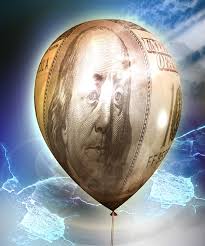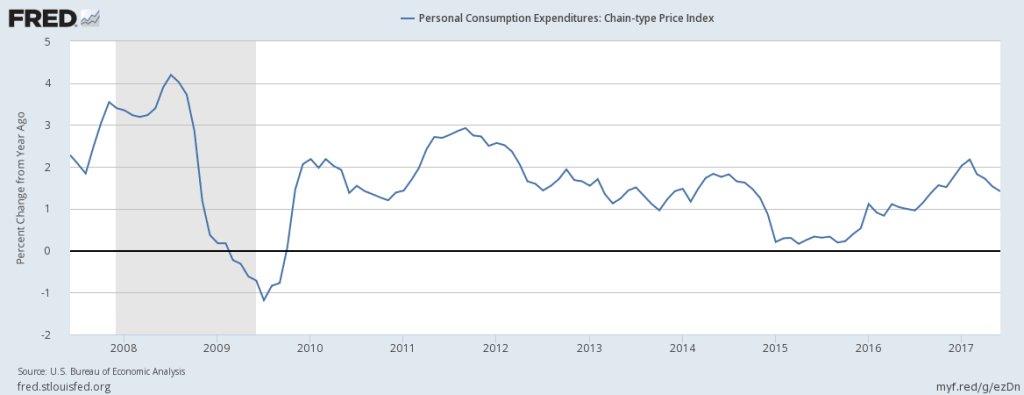Effects of inflation: Where’s The Inflation Monster?
Data continues to pour in showing that inflation is not an issue, clearly proving that the trend as we stated had not changed. The trend is still neutral but showing no signs of letting up. We never fight a trend; if the trend changes tomorrow, no matter what personal views we hold, we will not allow them to influence us. If the trend changes tomorrow, we will embrace the new trend without any resistance. A trend in motion is unstoppable. The stories below illustrate how the masses are being fed a false storyline
Weak inflation has spurred concerns that the Fed may have to cool its monetary tightening pace even though the economy is growing moderately and the unemployment rate is at a 16-year low. The central bank is also considering reducing its $4.2 trillion portfolios of Treasury bonds and mortgage-backed securities. Full Story
Central Banks Told to Embrace Negative Rates as Recession Looms
The Effects of inflation story is now in the toilet and central bankers worldwide are preparing for an era of negative rates. We warned of this development years ago.
Investors and analysts are redoubling their warnings that with global borrowing costs already so low, central banks will need to be prepared to cut interest rates deep into negative territory in the next economic downturn. The message is taking on urgency as anxiety builds that the U.S. is nearing the end of its current economic expansion cycle. “I don’t think the central bankers would like to go back into negative rates once they get out of it, but the reality is they may well have to during the next recession,” Iain Stealey, the head of global aggregate strategies at JPMorgan Asset Management in London, said in a Bloomberg TV interview Monday.
The market value of the world’s negative-yielding bonds has jumped almost 25 percent over the past month to $8.6 trillion amid slower-than-forecast inflation data and as investors piled into the safest securities as perceptions of geopolitical risk increased. That’s happened even after Federal Reserve officials started raising benchmark borrowing costs and said they would begin running off their $4.5 trillion balance sheet “relatively soon.”
“Assuming we normalize over the next couple of years, going back to negative rates is certainly possible,” Reinhard Cluse, chief European economist at UBS AG, said in a Bloomberg TV interview Monday. “ Full Story
The crowd is being prepped for the next problem; a problem that does not exist at least not yet. Only this time the crowd will accept the solution before the problem manifests. Fear is a powerful tool and the masses always fall for the “world is going to end story”.
Bank of England Joins the plethora of central bankers refusing to raise rates
They were talking quite boldly not too long ago about raising rates; sounds familiar for that’s what the Fed was boldly proclaiming not too long ago.
The Monetary Policy Committee (MPC) voted by a majority of 6-2 to keep rates at record low levels in August.
The U.K.’s central bank maintained stock levels of government bonds and corporate bonds at £435 billion and £10 billion respectively.
The MPC also said it forecast two interest rate hikes over the next three years, one more than it had estimated previously. Full Story
We expect them to backtrack again and again. If they do raise rates, it will be only to buy them more room in the future. There are too many deflationary forces being unleashed from multiple sectors; in some cases, the trend has just begun. Central bankers are getting away with murder right now. Inflation (by its true definition is in full swing) but prices remain low. At this point, they can almost have their cake and their pie. The ones getting hit hard are savers, especially those on fixed incomes.
At Jackson Hole, Yellen was unusually silent when it came to discussing rate hikes; instead, she focused on the financial stability of markets and bank regulation; a clear signal that the Fed is changing its tune.
“The balance of research suggests that the core reforms we have put in place have substantially boosted resilience without unduly limiting credit availability or economic growth,”
On a separate note, the odds are now almost 85% that Trump will fire Yellen as the mandate going forward is get rid of Dodd-Frank; Yellen’s statement at Jackson Hole indicates that she disagrees with this view.
Tactical Investor take on The Effects of inflation
 In the past five years, the personal consumption expenditures price index traded past the Fed’s 2% target only twice; In Jan 2017 and Feb 2017. As you can see the Fed and most economists are full of it, when it comes to the inflation is here argument. They are selling a story with no legs. They continue to drum up excuses to account for this strange behaviour, calling them anomalies or idiosyncrasies. Reality is that deflation might be here for a long time.
In the past five years, the personal consumption expenditures price index traded past the Fed’s 2% target only twice; In Jan 2017 and Feb 2017. As you can see the Fed and most economists are full of it, when it comes to the inflation is here argument. They are selling a story with no legs. They continue to drum up excuses to account for this strange behaviour, calling them anomalies or idiosyncrasies. Reality is that deflation might be here for a long time.
Price wars are coming on multiple fronts, and as margins get squeezed, automation will be the only option on the table. In the not too distant future, the number of workers at any given theatre will drop by as much as 90%. Wage deflation is a trend that is almost a trend in motion. The trend for wage inflation is now neutral, and it keeps moving lower and lower. When it turns negative, the wage deflation trend will start, and it will last for a long time as this is a megatrend.
Other Articles of Interest
Stock market Crash Myths and Realities (Jan 3)
Bull-Bear Markets & Arrogance (Jan 1)
Will The Stock Market Crash In 2018 (Dec 11)
Has US Dollar Finally Hit Bottom (Dec 6)
BitCoin Has Done What Precious Metals Never Could (Dec 4)
Experts Making Stock Market Crash Forecasts usually know nothing (Nov 17)
1987 stock market crash anniversary discussions- nothing but rubbish ( Oct 24)
Dow 22K Predicted In July 2017; Next Target Dow 30k? (Oct 15)
Anxiety and Greed Index Don’t Support Stock Market Crash (Oct 14)




